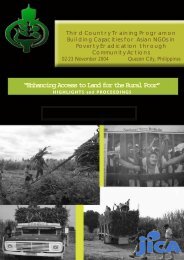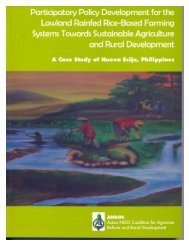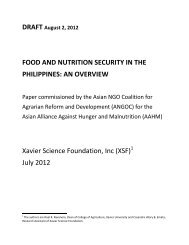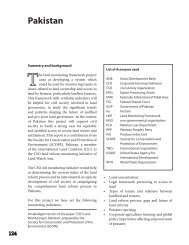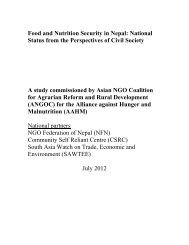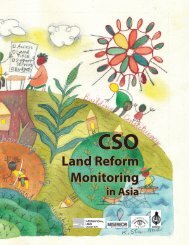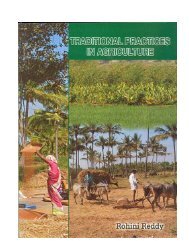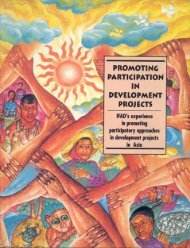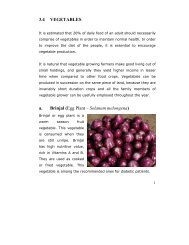Securing the Right to Land FULL - ANGOC
Securing the Right to Land FULL - ANGOC
Securing the Right to Land FULL - ANGOC
You also want an ePaper? Increase the reach of your titles
YUMPU automatically turns print PDFs into web optimized ePapers that Google loves.
SECURING THE RIGHT TO LAND<br />
94<br />
development played a key role in this. The Green Revolution<br />
program and technological advancements led <strong>to</strong> an increase in<br />
productivity of 5.6% and by 1984, <strong>the</strong> country had attained<br />
self-sufficiency in food. Rice production was correlated with<br />
improved living conditions among rural communities.<br />
In spite of this, <strong>the</strong> Green Revolution advanced largely via monoculture<br />
systems—which were forced upon all regions, despite<br />
<strong>the</strong>ir geographic diversity and different bases of subsistence,<br />
e.g., corn, sweet pota<strong>to</strong> and o<strong>the</strong>r crops—making food security<br />
more susceptible <strong>to</strong> climate change and resulting in ecological<br />
degradation. The Green Revolution also highlighted <strong>the</strong> dependency<br />
of small-scale farmers and farm workers on <strong>the</strong>ir landlords<br />
and on expensive agricultural inputs, often imported, such<br />
as seedlings, fertilizers, and pesticides.<br />
The fourth phase was deconstruction (1986–1997). As a result<br />
of policies which had been adopted previously, <strong>the</strong> agricultural<br />
sec<strong>to</strong>r contracted during this period, with growth as low as<br />
3.4% per year. Policymakers and economists neglected agriculture<br />
until <strong>the</strong> sec<strong>to</strong>r was in serious need of repair. The dark days<br />
of agriculture grew worse with <strong>the</strong> introduction of technocratic<br />
economic policies which aimed at a large-scale, though footloose,<br />
industrialization strategy in <strong>the</strong> early 1990s.<br />
Since <strong>the</strong> mid-1980s, several components protecting industrial<br />
sec<strong>to</strong>rs had been in place, contributing <strong>to</strong> double-digit growth<br />
in <strong>the</strong> industrial and manufacturing sec<strong>to</strong>rs. At that time, <strong>the</strong><br />
notion that Indonesia was already capable of transfoming itself<br />
Table 1. Growth in Indonesia’s Agricultural Sec<strong>to</strong>r (% per year)<br />
from an agrarian nation <strong>to</strong> an industrial nation gained currency.<br />
Policies which <strong>the</strong> government adopted at that point were geared<br />
<strong>to</strong>ward channeling all <strong>the</strong> resources from <strong>the</strong> agricultural sec<strong>to</strong>r<br />
<strong>to</strong> industry, because <strong>the</strong> government believed that agricultural<br />
projects could not produce results as fast as industry or urban<br />
investments. A policy of subsidizing industry by stabilizing <strong>the</strong><br />
prices of basic goods was adopted <strong>to</strong> pander <strong>to</strong> urban workers.<br />
This policy led <strong>to</strong> <strong>the</strong> destruction of farmers’ livelihoods and <strong>the</strong><br />
deterioration of agricultural development in Indonesia.<br />
The fifth phase was <strong>the</strong> crisis period (1997–2001). In this phase,<br />
<strong>the</strong> already struggling agricultural sec<strong>to</strong>r had <strong>to</strong> face <strong>the</strong> impact<br />
of <strong>the</strong> crisis, namely absorbing surplus labor from <strong>the</strong> informal<br />
and urban sec<strong>to</strong>rs, thus saving <strong>the</strong> Indonesian economy. The<br />
dependence of farmers on expensive productive inputs from<br />
abroad—a result of past policies—boomeranged on <strong>the</strong> farmers<br />
when harvests failed because of droughts. During <strong>the</strong> crisis, fertilizer<br />
subsidies were withdrawn and imported rice—ei<strong>the</strong>r in <strong>the</strong><br />
form of food aid or smuggled rice—flooded <strong>the</strong> domestic market.<br />
The sixth phase is transition and decentralization (2001–<br />
present). This period is very uncertain for both economic players<br />
and <strong>the</strong> Indonesian agricultural sec<strong>to</strong>r. Despite decentralization,<br />
agricultural development has not moved forward because of <strong>the</strong><br />
lack of regional au<strong>to</strong>nomy and authority, which are essential <strong>to</strong><br />
formulating strategies based on comparative and competitive<br />
advantages. Left <strong>to</strong> regional governments, <strong>the</strong> agricultural sec<strong>to</strong>r<br />
is increasingly being neglected. A summary of <strong>the</strong> development<br />
path taken by Indonesian agriculture can be seen in Table 1.<br />
PHASE FOOD PLANTATION LIVESTOCK FISHERIES TOTAL<br />
AGRICULTURE<br />
Revolutionary 1945-1965 2.38 1.90 — — 2.40<br />
Consolidation 1967-1978 3.58 4.53 2.02 3.44 3.39<br />
High Growth 1978-1986 4.95 5.85 6.99 5.15 5.72<br />
Deconstruction 1986-1997 1.90 6.23 5.78 5.36 3.38<br />
Economic Crisis 1997-2001 1.62 1.29 -1.92 5.45 1.57<br />
Decentralization 2001-present 2.81 5.85 5.19 4.59 3.83<br />
Source: Calculated by Bustanul Arifin based on data of BPS and FAO, as cited in Sri Hartati Samhadi, op.cit., 16 August 2005, hal. 50.<br />
Notes:<br />
Growth statistics for <strong>the</strong> revolutionary period (1945–1965) are taken from several sources, including Booth (1998), for food and plantation, and<br />
FAO for <strong>to</strong>tal agriculture.<br />
Figures for <strong>the</strong> modern periods (1967–2004) are calculated from GDP in <strong>the</strong> agricultural sec<strong>to</strong>r, from publication by BPS and FAO (several years).<br />
Forest subsec<strong>to</strong>r is taken out of <strong>the</strong> calculation because of different characteristics.



